Tailoring the Silicon Cementation Applied to P265GH Grade Steel
Abstract
1. Introduction
2. Materials and Methods
- -
- Ferrosilicon (FeSi75C) with 72 ÷ 75%Si, less than 0.1%C, and about 2%Al produced by the Norwegian company FINNFJORD; fragments with an average equivalent diameter of 40 ÷ 50 mm, subsequently ground in ball mills to average diameters equivalent to 3 ÷ 4 mm.
- -
- Silica (SiO2) with a purity greater than 99.8% and an average particle diameter of about 23 μm, produced by Luoyang Tongrun Info Technology Co., Ltd., Luoyang, China.
- -
- Aluminum powder, produced by air spraying in Zlatna, Romania, via the Sherritt hydrometallurgical process, of 99.2% purity (containing 0.15%Fe; 15%O2; 0.5%N2) with an average particle diameter of about 50 μm.
- -
- Alumina powder (Al2O3) with a purity greater than 98.5% was produced at Alum S.A. Romania; a fraction greater than 150 μm (max. 10%) and a fraction less than 45 μm (max. 12%).
- -
- Ammonium chloride (NH4Cl) of analytical purity produced by Silver Chemicals Romania.
- -
- Vickers HV0.05 (50 gf) hardness tests were performed on the NEOPHOT 21 N1096 series microscope.
- -
- Optical Microscopy (OM) using a Zeiss Z1m Observer microscope—Axio Vision 4.8/038-12837 (Carl Zeiss GmbH, Gottingen, Germany).
- -
- XRF analyses performed on the SPECTRO xSORT device (SPECTRO Analytical Instruments GmbH, Kleve, Germany) used to verify silicon concentration in the superficial siliconized coating.
- -
- Energy-dispersive spectrometry (EDS Sapphire-type energy-dispersive spectrometer with a resolution of 128 kV) using a Phenom ProX SEM (Eindhoven, The Netherlands).
- -
- Cutting of P265GH grade steel samples with dimensions of 15 × 15 × 20 mm.
- -
- Packing in powdery solid mixtures with the composition FeSi75C or (SiO2 + Al) + NH4Cl + Al2O3 in refractory stainless-steel boxes sealed with refractory stainless-steel lids and clay latches; simultaneously, pure technical iron foils were introduced for the determination of silicon and aluminum content.
- -
- Thermal processing itself under the conditions imposed by the experimental program adopted.
- -
- Sample preparation.
- -
- Optical and electronic SEM/EDAX microscopy); XRF analyses.
- -
- Statistical processing of the experimental data obtained (the processing modality specific to the type of program adopted).
- -
- Conclusions.
3. Results and Discussion
- bi; bij—the real coefficients of Equation (1).
- xi; xj—the coded values of the factors (independent parameters used in analysis).
- Y—the real value of the dependent parameter. Thus, in the presented situation, Y represents the thickness of the compact and adherent siliconized layer, devoid of porosity, and formed on the surface of the product subjected to thermochemical processing or the value of the ratio of the Si mass proportions and Al in the superficial areas of the obtained layer.
- xi—the coded value of the independent parameter i (or j, k … ij, ik … ijk).
- Xi0—the natural value of the independent parameter i (or j, k … ij, ik … ijk) corresponding to the chosen base level (Table 2).
- S02—the dispersion of the reproducibility of the experimental results obtained by performing three experiments in identical conditions, corresponding to the upper level of the independent parameters.
- S2bi; ij—the dispersion with which the bij; bijk coefficients are calculated.
- -
- Si appears in the superficial areas of thermochemically processed metal parts because of a sequence of chemical reactions, frequently between the chlorides adsorbed in the superficial layers and iron atoms (Equation (14)), or in the vicinity of the surface, because of the reactions between chlorides and hydrogen resulting from the decomposition of ammonium chloride (Equation (16)) or ammonia (Equation (9)).
- -
- Si can also appear because of the aluminothermic reaction (Equation (18)), in which case, being dependent on the position of the micro-volume in which the reaction takes place in relation to the thermochemically processed surface, it can either be adsorbed (if it is in the vicinity of the surface) or it can react with hydrochloric acid, for example, generating chlorides.
- -
- Most reactions that take place between the components of the solid powdery media used for silicon cementation take place with the release of heat. The aluminothermic reaction (Equation (18)) obviously has the greatest thermal effect, which determines much higher kinetics of the process than those recorded in the case of using ferrosilicon as the active component and ensuring the possibility of carrying out the process at much lower temperatures without affecting the kinetics.
- -
- The appearance of silicon chlorides is dependent on the presence of ammonium chloride among the components of the powdery solid media and its decomposition at the processing temperature (Equation (8)). Increasing the proportion of this component also has negative consequences in the sense that there is continuous cleaning/corrosion of the surface, which is an aspect that must be considered when choosing its proportion.
- -
- The appearance of Si in a free state in the powdery solid media (Equations (12), (16) and (18)) can be determined as extremely likely from a thermodynamic point of view, as shown in Figure 2, in the formation of a nitride type (Si2N), according to the reaction:where nitrogen in the atomic state results from the thermo-catalytic decomposition reaction of ammonia (Equation (9)).2Si + N = Si2N
(ΔG950°C = −376.1 kJ/mol, and ΔH950°C = −742.1 kJ/mol)
(ΔG950°C = −48.3 kJ/mol, and ΔH950°C = 111.6 kJ/mol)
(ΔG950°C = −112.4 kJ/mol, and ΔH950°C = −110.7 kJ/mol)
(ΔG950°C = −92 kJ/mol, and ΔH950°C = 48.9 kJ/mol)
(ΔG950°C = −74.1 kJ/mol, and ΔH950°C = −384.1 kJ/mol)
(ΔG950°C = 87.3 kJ/mol, and ΔH950°C = −298.6 kJ/mol)
- -
- An increase in the proportion of NH4Cl in the solid powdery mixture will impose an increase in the Al percentage (a decrease in the ratio of mass proportions related to Si and Al) in the superficial layer, which is more intense as the proportion of the thermite mixture (active component) is higher and the temperature is higher, as shown in Figure 8b.
- -
- For low proportions of the halide in the solid powdery mixture, as shown in Figure 8a, the probability of developing the aluminothermic reaction (18) in volume is higher because the proportion of hydrochloric acid vapors resulting from the decomposition of the halide is lower, so the development of Equations (21), (23) and (24) will be favored by a reduction in the proportion of the thermite mixture in the general powdery mixture.
4. Conclusions
- (a)
- FeSi75C with high concentrations of silicon (over 70 wt%) represents a redoubtable active component especially in the range of temperatures above 1100 °C. The most intense kinetics of the formation of the area of interest of the silicon-cemented coating is obtained for high values of the proportion of FeSi75C in the medium and similarly for the processing temperature, as well as for the holding time, which is associated with low values of the activating component (about 3 wt%).
- (b)
- The mechanism by which the superficial saturation with Si takes place is very likely both atomic and ionic; during holding at the silicon cementation temperature, all the conditions are created for the synthesis reaction of silicon nitride Si2N and its subsequent ionization with the formation of cationic complexes of the Si2N+ type.
- (c)
- The use of the powdery thermite mixture (SiO2 + Al) as the active component of the solid medium certainly ensures an intensification of the coating growth kinetics with a chemical and phase composition different from that of the matrix, but it will have the predominant characteristics of an alited coating (aluminum cemented), so it is not a solution to be considered for pack silicon cementation.
- (d)
- The calculated and statistically verified mathematical models allow the anticipation by calculation of how we can associate the parameters with significant influence on the growth kinetics of the thickness in the silicon-cemented coating devoid of porosity in order to maximize this thickness or how we can combine parameters (in the case of using the thermite mixture) in such a way that we obtain a value of practical interest of the ratio between the proportions of the two elements in the coating. In this way, the control of the silicon cementation process becomes more effective and its efficiency increases.
Author Contributions
Funding
Institutional Review Board Statement
Informed Consent Statement
Data Availability Statement
Conflicts of Interest
References
- Garverick, L.; Scott, D.H.; Scott, W.W., Jr. Corrosion in the Petrochemical Industry, 3rd printing; ASM International: Novelty, OH, USA, 1999; pp. 11–17. ISBN 0-87170-505-2. [Google Scholar]
- Leahovici, L.S.; Voroşnin, L.G.; Şcerbakov, E.R.D.; Panin, G.G. Siliconization of Metals and Alloys; Tehnica, N.I., Ed.; Scientific and Technical Publishing House: Minsk, Russia, 1972; pp. 149, 167, 188–193, 194–210. (In Russian) [Google Scholar]
- Lahtin, I.M.; Arzamasov, B.N. Thermochemical Treatments of Steels; Metallurghia (Metallurgy Publishing House): Moscow, Russia, 1985; pp. 221–229. (In Russian) [Google Scholar]
- Kubachewski von Goldbeck, O. Fe-Si Iron-Silicon. In IRON-Binary Phase Diagrams; Springer: Berlin/Heidelberg, Germany, 1982; pp. 136–139. [Google Scholar] [CrossRef]
- Sen, U.; Ozdemir, O.; Yilmaz, S.; Sen, S. Kinetics of Iron Silicide Deposited on AISI D2 Steel by Pack Method. In Proceedings of the 22nd International Conference on Metallurgy and Materials (METAL 2013), Brno, Czech Republic, 15–17 May 2013; p. 965, ISBN 978-80-87294-39-0, ISSN 2694-9296. [Google Scholar]
- SA 516 Steel Plate. Overview of SA 516 60, SA 516 65 & SA 516 70. Available online: https://www.aasteel.com/sa-516/?print=pdf (accessed on 17 September 2023).
- EN 10028-2. Available online: http://www.boilersteel.com/alloy-steel/en-10028-2-steel-plate.html (accessed on 17 September 2023).
- Taloi, D.; Florian, E.; Bratu, C.; Berceanu, E. Optimization of Metallurgical Processes; Didactic and Pedagogical Publishing House: Bucharest, Romania, 1983; pp. 79–96, ISBN/COD:240IPCLUOP. (In Romanian) [Google Scholar]
- Dimitriu, S.; Taloi, D. Mathematical Modeling Methods of Technological Processes; Printech, Printech Publishing House: Bucuharest, Romania, 2014; pp. 181–206. (In Romanian) [Google Scholar]
- Stechauner, S. Diffusion of aluminum in ferrite and austenite—MatCalc example D30; MatCalc Version:5.44.1002; Austria. 2012. Available online: https://www.matcalc.at/wiki/doku.php?id=examples:diffusion:d30 (accessed on 17 September 2023).
- Paukstis, S.J.; Gole, J.L. The Ionization Potential of Si2N and Si2O. J. Phys. Chem. A 2002, 106, 8435–8441. [Google Scholar] [CrossRef]
- Balandin, Y.A.; Kolpakov, A.S. Diffusion Siliconizing in a Fluidized Bed. Met. Sci. Heat Treatmen 2006, 48, 127–130. [Google Scholar] [CrossRef]
- Popoola, A.P.I.; Aigbodion, V.S.; Fayomi, O.S.I.; Abdulwahab, M. Experimental Study of the Effect of Siliconizing Parameters of Thermochemical Treatment of Low Carbon Steel. Silicon 2016, 8, 201–210. [Google Scholar] [CrossRef]
- Hsu, H.W.; Tsai, W.T. High temperature corrosion behavior of siliconized 310 stainless steel. Mater. Chem. Phys. 2000, 64, 147–155. [Google Scholar] [CrossRef]
- Soderhjelm, C. Multi-Material Metal Casting: Metallurgically Bonding Aluminum to Ferrous Inserts. Ph.D. Thesis, Philosophy in Materials Science and Engineering, Worcester Polytechnic Institute, Worcester, MA, USA, 2017. [Google Scholar]
- Fujikawa, S.; Hirano, K.; Fukushima, Y. Diffusion of silicon in aluminum. Metall. Trans. A 1978, 9, 1811–1815. [Google Scholar] [CrossRef]
- Mehrer, H.; Eggersmann, M.; Gude, A.; Salamon, M.; Sepiol, B. Diffusion in intermetallic phases of the Fe-Al and Fe-Si systems. Mater. Sci. Eng. A 1997, 239–240, 889–898. [Google Scholar] [CrossRef]
- Batz, W.; Mead, H.V.; Birchenall, C.E. Diffusion of Silicon in Iron. J. Met. 1952, 10, 1070. [Google Scholar] [CrossRef][Green Version]
- Mirani, H.V.M.; Maaskant, P. Diffusion of Si in Fe-Si Containing 8 to 11 at% Si. Phys. Status Solidi A 1972, 14, 521–525. [Google Scholar] [CrossRef]
- Isobe, T.; Nakashima, H.; Hashimoto, K. Diffusion Coefficient of Interstitial Iron in Silicon. Jpn. J. Appl. Phys. 1989, 28, 1282–1284. [Google Scholar] [CrossRef]
- Hirano, K.; Agarwala, R.P.; Cohen, M. Diffusion of iron, nickel and cobalt in aluminum. Acta Metall. 1962, 10, 857–863. [Google Scholar] [CrossRef]
- Ghertzriken, S.D.; Dehtear, I.I. Diffusion in Solid State Metals and Alloys; State Publishing House of Physics and Mathematics Literature: Moskva, Russia, 1960; pp. 522–526, (Romanian Translation). [Google Scholar]
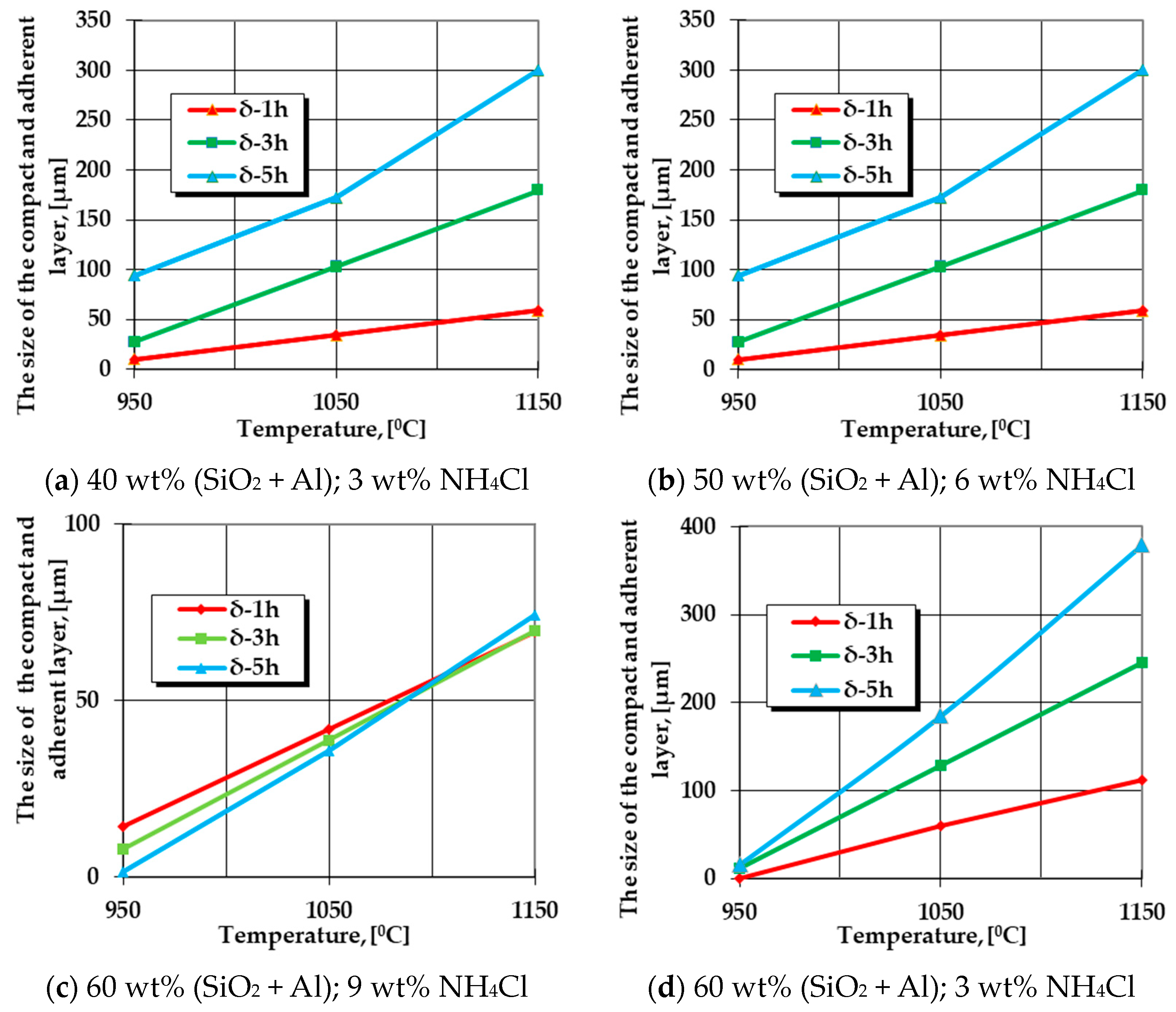
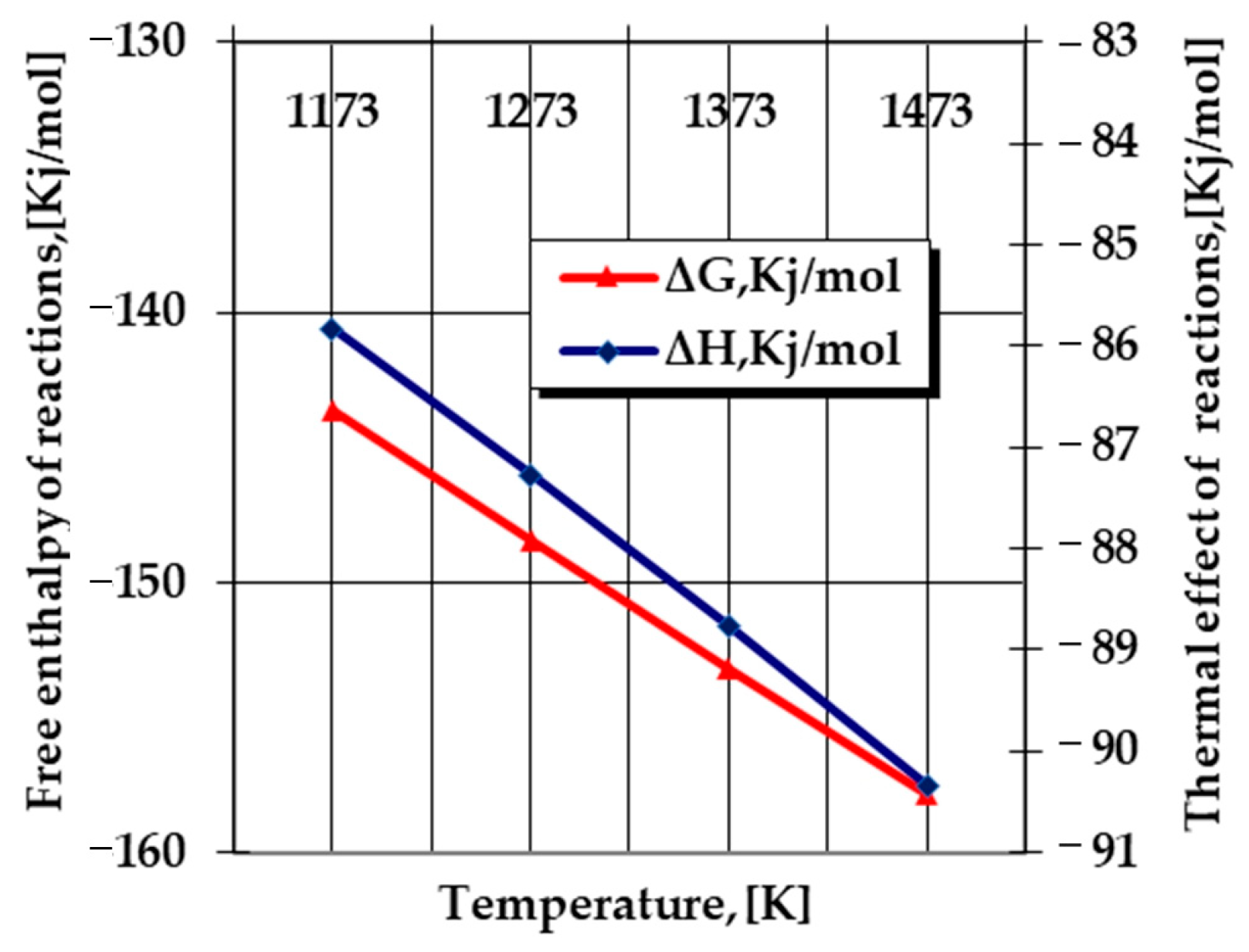


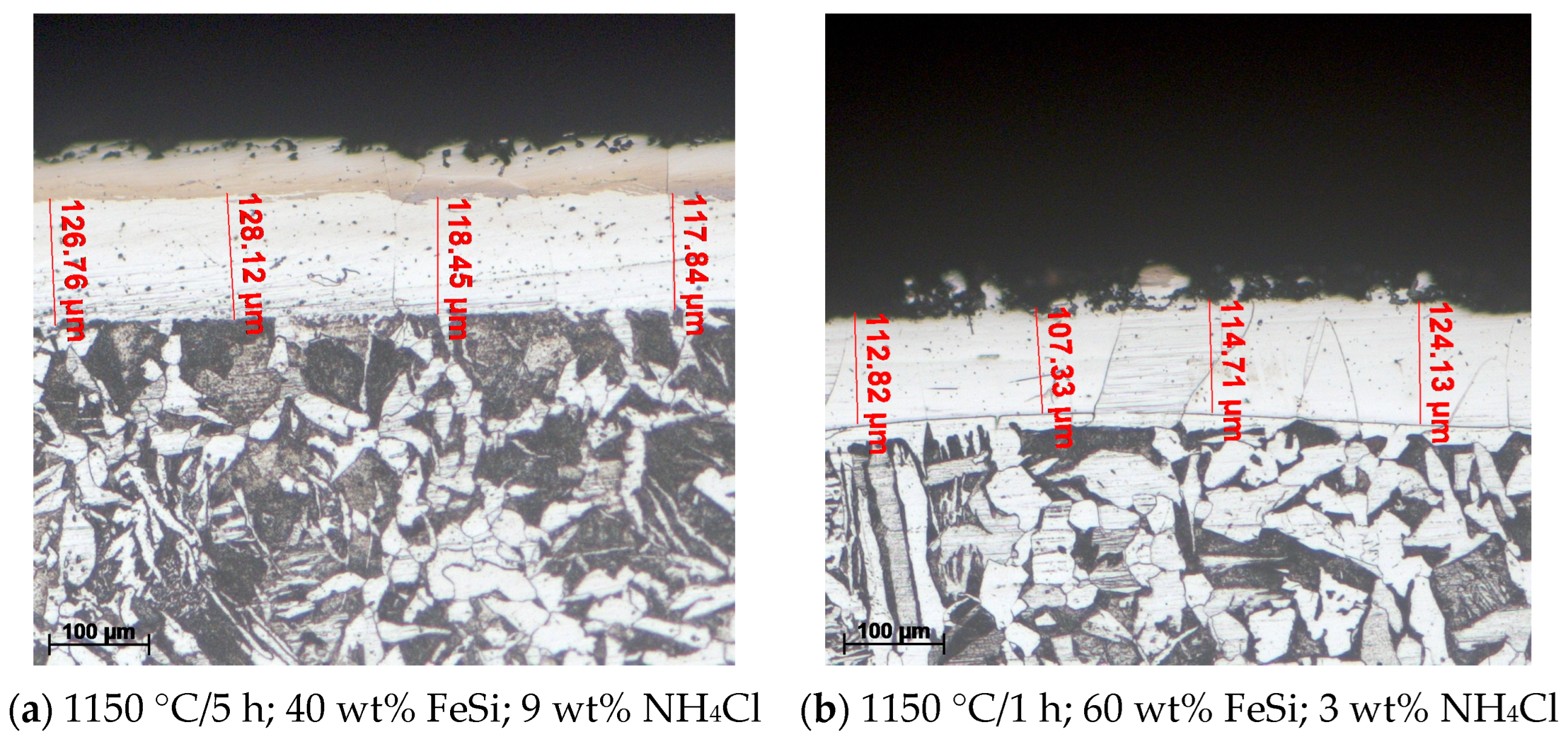
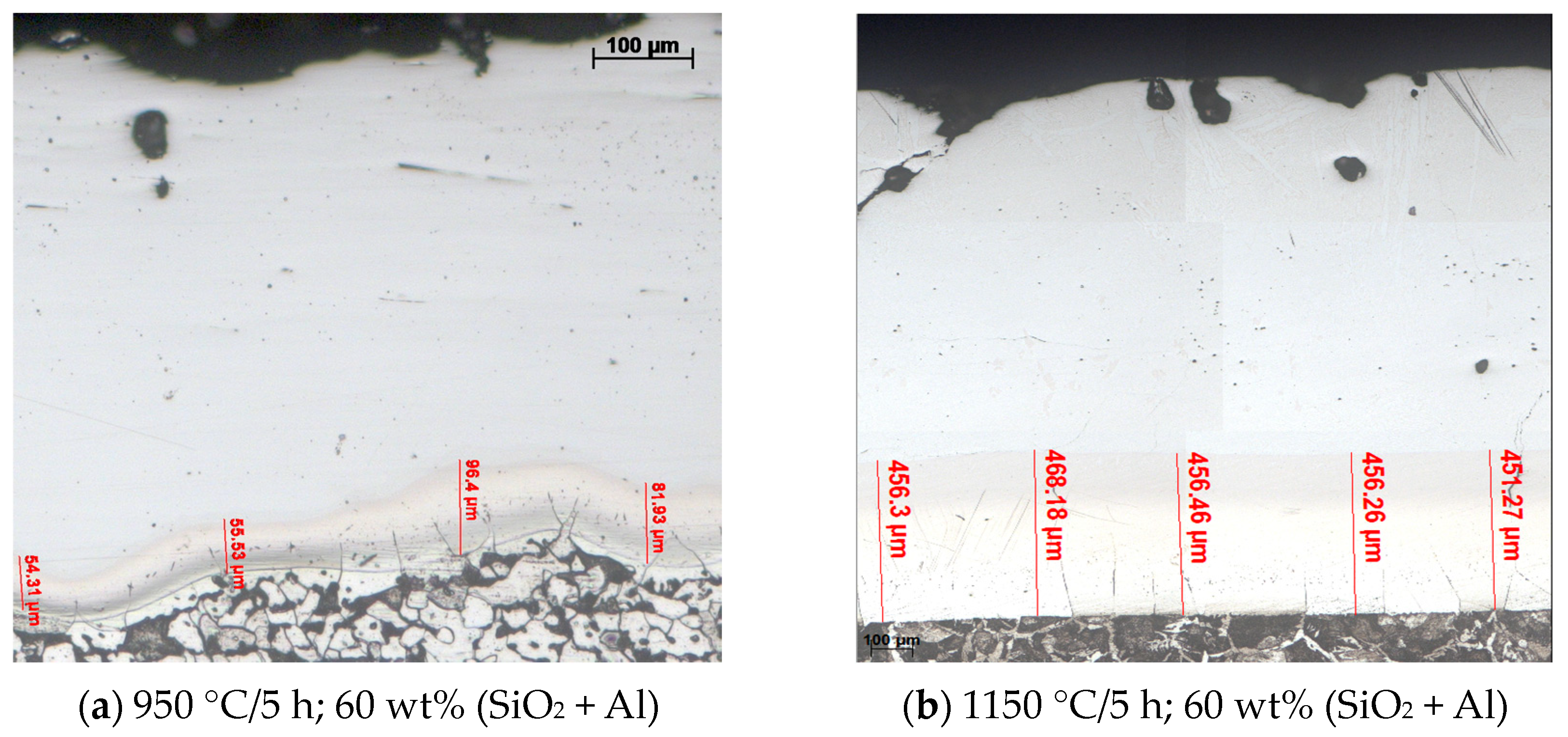
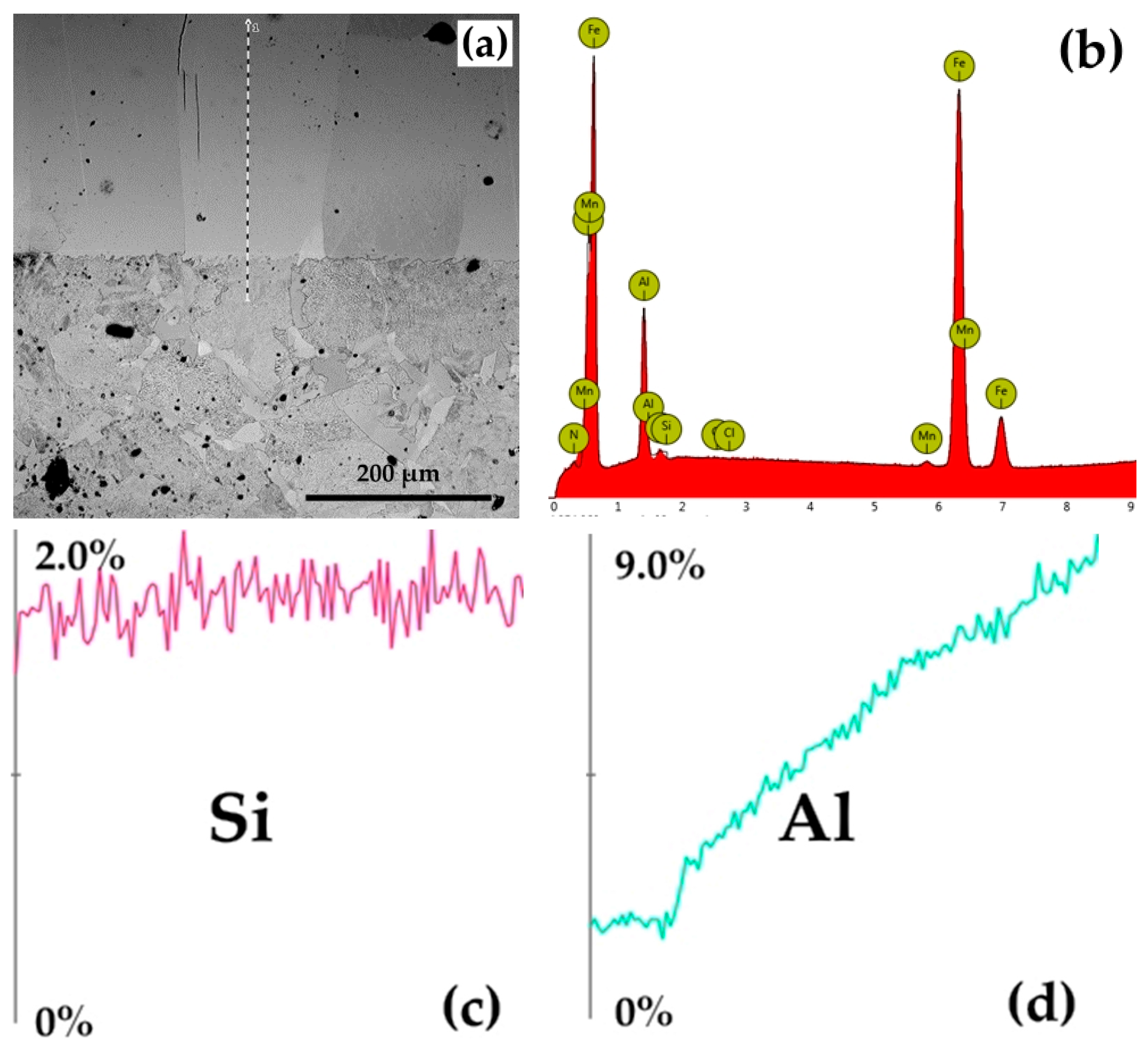

| % | C | Si | Mn | P | S | Cu | Ni | Cr | Mo | V | Al | Nb | Ti | N | Fe |
|---|---|---|---|---|---|---|---|---|---|---|---|---|---|---|---|
| P265GH | 0.10 | 0.23 | 1.05 | 0.014 | 0.004 | 0.03 | 0.02 | 0.04 | 0.004 | 0.002 | 0.043 | 0.001 | 0.002 | 0.009 | rest |
| SR EN ISO 10028-2:2017 | Max 0.20 | Max 0.40 | 0.80–1.40 | Max 0.025 | Max 0.015 | Max 0.30 | Max 0.30 | Max 0.30 | Max 0.08 | Max 0.02 | Min 0.020 | Max 0.020 | Max 0.03 | Max 0.012 | rest |
| Factors | T, (°C) X1 | t, (h) X2 | FeSi75C or (SiO2 + Al) (%) X3 | NH4Cl, (%) X4 | δ—Experimental (μm) Y | %Si/%Al (a.u.) Y’ | |
|---|---|---|---|---|---|---|---|
| Active Component | |||||||
| FeSi75C | (SiO2 + Al) | ||||||
| Variation interval (ΔXi) | 100 °C | 2 h | 10% | 3% | - | - | - |
| Higher value (Xi0 + ΔXi) | (+1)/1150 °C | (+1)/5 h | (+1) 60% | (+1) 9% | - | - | - |
| Base value (Xi0) | (0)/1050 °C | (0)/3 h | (0) 50% | (0) 6% | - | - | - |
| Lower value (Xi0-ΔXi) | (−1)/950 °C | (−1)/1 h | (−1) 40% | (−1) 3% | - | - | - |
| Exp.1 | (+1)/1150 °C | (+1)/5 h | (+1) 60% | (+1) 9% | 71.87 | 511.44 | 0.37 |
| Exp.2 | (+1)/1150 °C | (+1)/5 h | (+1) 60% | (−1) 3% | 382.62 | 457.69 | 4.98 |
| Exp.3 | (+1)/1150 °C | (+1)/5 h | (−1) 40% | (+1) 9% | 121.80 | 268.24 | 0.909 |
| Exp.4 | (+1)/1150 °C | (−1)/1 h | (+1) 60% | (+1) 9% | 74.52 | 243.64 | 1.60 |
| Exp.5 | (−1)/950 °C | (+1)/5 h | (+1) 60% | (+1) 9% | 0.00 | 98.23 | 0.648 |
| Exp.6 | (+1)/1150 °C | (+1)/5 h | (−1) 40% | (−1) 3% | 296.76 | 508.21 | 4.45 |
| Exp.7 | (+1)/1150 °C | (−1)/1 h | (+1) 60% | (−1) 3% | 115.36 | 364.58 | 9.09 |
| Exp.8 | (+1)/1150 °C | (−1)/1 h | (−1) 40% | (+1) 9% | 143.19 | 494.90 | 4.50 |
| Exp.9 | (−1) 950 °C | (−1)/1 h | (+1) 60% | (+1) 9% | 0.00 | 166.52 | 1.95 |
| Exp.10 | (−1)/950 °C | (+1)/5 h | (−1) 40% | (+1) 9% | 0.00 | 72.90 | 2.10 |
| Exp.11 | (−1)/950 °C | (+1)/5 h | (+1) 60% | (−1) 3% | 0.00 | 34.65 | 0.00 |
| Exp.12 | (−1)/950 °C | (−1)/1 h | (−1) 40% | (+1) 9% | 0.00 | 56.59 | 0.00 |
| Exp.13 | (−1)/950 °C | (−1)/1 h | (+1) 60% | (−1) 3% | 7.18 | 22.42 | 0.00 |
| Exp.14 | (−1)/950 °C | (+1)/5 h | (−1) 40% | (−1) 3% | 60.40 | 65.56 | 0.276 |
| Exp.15 | (+1)/1150 °C | (−1)/1 h | (−1) 40% | (−1) 3% | 55.27 | 224.85 | 0.00 |
| Exp.16 | (−1)/950 °C | (−1)/1 h | (−1) 40% | (−1) 3% | 9.85 | 22.62 | 3.18 |
| Coefficient | Active Component: FeSi Y—(δ) | Active Component: (SiO2 + Al) Y—(δ) and Y′—(%Si/%Al) mass × 100 | |||
|---|---|---|---|---|---|
| b0 | 83.67 | N = 16 | 225.81 | N = 16 | 2.12 |
| b1 | 73.99 | 158.38 | 1.109 | ||
| b2 | 32.98 | 42.78 | −0.168 | ||
| b3 | −2.23 | −0.12 | 0.22 | ||
| b4 | −32.25 | 8.461 | −0.881 | ||
| b12 | 27.58 | 9.41 | −0.392 | ||
| b13 | 5.65 | 10.26 | 0.552 | ||
| b14 | −22.57 | −13.09 | −0.511 | ||
| b23 | −0.826 | 24.78 | −0.156 | ||
| b24 | −36.01 | −15.95 | −0.113 | ||
| b34 | −12.59 | −12.17 | −0.853 | ||
| b123 | 6.39 | 21.44 | −0.619 | ||
| b124 | −30.58 | 39.42 | −0.535 | ||
| b234 | 3.17 | 0.006 | 0.288 | ||
| b134 | −20.47 | −34.16 | −0.785 | ||
| b1234 | −4.04 | 46.16 | 1.076 | ||
| Parameter | Active Component: FeSi for δ | Active Component: (SiO2 + Al) for: δ—%Si/%Al | |||
|---|---|---|---|---|---|
| S02 | 146.10 | t = 2.12 | 923.65 | t = 2.12 | 0.46 |
| Sbi2; Sbij2 | 9.13 | 57.73 | 0.0288 | ||
| Δbi; Δbij… | ±6.40 | ±16.10 | ±0.36 | ||
| Statistical parameter | The active component: FeSi | The active component: (SiO2 + Al) | |||
| Y = δ | S02 = 54.31 | (1) Y δ | (1) Y > S02 = 244.2 (2) Y’ > S02 = 0.46 | (2) Y’ %Si/%Al | |
| Ftabuleted | 19.4 | 19.37 | 19.30 | ||
| S2conc | 85.86 | 2101 | 0.548 | ||
| Fcalculated | 0.587 | 2.27 | 1.19 | ||
Disclaimer/Publisher’s Note: The statements, opinions and data contained in all publications are solely those of the individual author(s) and contributor(s) and not of MDPI and/or the editor(s). MDPI and/or the editor(s) disclaim responsibility for any injury to people or property resulting from any ideas, methods, instructions or products referred to in the content. |
© 2024 by the authors. Licensee MDPI, Basel, Switzerland. This article is an open access article distributed under the terms and conditions of the Creative Commons Attribution (CC BY) license (https://creativecommons.org/licenses/by/4.0/).
Share and Cite
Branzei, M.; Cojocaru, M.O.; Morariu, M.D.; Druga, L.N. Tailoring the Silicon Cementation Applied to P265GH Grade Steel. Coatings 2024, 14, 74. https://doi.org/10.3390/coatings14010074
Branzei M, Cojocaru MO, Morariu MD, Druga LN. Tailoring the Silicon Cementation Applied to P265GH Grade Steel. Coatings. 2024; 14(1):74. https://doi.org/10.3390/coatings14010074
Chicago/Turabian StyleBranzei, Mihai, Mihai Ovidiu Cojocaru, Mircea Dan Morariu, and Leontin Nicolae Druga. 2024. "Tailoring the Silicon Cementation Applied to P265GH Grade Steel" Coatings 14, no. 1: 74. https://doi.org/10.3390/coatings14010074
APA StyleBranzei, M., Cojocaru, M. O., Morariu, M. D., & Druga, L. N. (2024). Tailoring the Silicon Cementation Applied to P265GH Grade Steel. Coatings, 14(1), 74. https://doi.org/10.3390/coatings14010074






